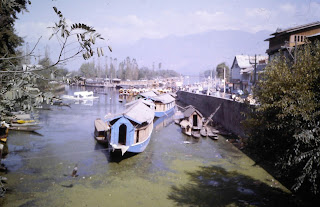I washed both pairs of my filthy trousers before joining George for breakfast in the Jaggi Restaurant. From there we went on to the Post Office to dispatch Taj Mahal postcards to friends and family at home. We were unsure of the advice given to make sure that the postcards were franked so that the postal workers didn’t just bin them an reuse the stamps and, as we weren’t given much option to do otherwise, we handed over our cash and left it to fate.
I bought a new slide film for 95 Indian Rupees on the way to the Agra Fort and sent an aerogramme to my old workmates at BP Research Centre giving them the Delhi Youth Hostel address. Admission to the Fort was 2 Indian Rupees and we spent a while wandering about.
Agra Fort is a historical fort which was the main residence of the emperors of the Mughal Dynasty until 1638, when the capital was shifted from Agra to Delhi. Before capture by the British, the last Indian rulers to have occupied it were the Marathas. In 1983, the Agra fort was inscribed as a UNESCO World Heritage site. It is about 2.5 km northwest of its more famous sister monument, the Taj Mahal. The fort can be more accurately described as a walled city.
Although it looked impressive from afar, the red stone fort was in a bad state of repair and the maze of (often blind) alleys were very shoddy. An apathetic native hacked at the overgrown lawn with a knife as we passed into a high court overlooking the Yamuna river and the Taj Mahal. We tarried here in the blazing sun for a while before setting off for the Taj Mahal.
The usual entourage of hawkers and rickshaws tagged along behind us. Our drink stops were becoming more frequent and near the gate to the Taj Mahal we stopped for a cuppa. A fan which would have been effective as a propeller on a light aircraft revved as if for take-off as the waiter brought our pot of tea. There were also two of the metal deceit cups that we had seen before, which had the appearance of a half pint mug, but the capacity of an egg cup. We made our second visit to the Taj Mahal and indulged in a massive photo session around the grounds of this iconic site.
We sauntered around watching Indians taking family photos with cheap pocket instamatics (no selfies at that time!) and foreign tourists festooned to photographic excess with everything from zoom lenses to cine cameras.
We were approached by a fellow who was not actually after money, but chatted to George in rudimentary English. “English is a monkey language”, he explained good naturedly. As a large crowd of gawpers began to gather we left for the tea shop through the ever-present vendors. After trudging back to Jaggis we stumbled into the restaurant opposite. Barely alive I had a chicken bone curry while George stuck to the old standby, egg curry. We finished just as a large party of cringe-making Europeans came into the place and began fussing over the menu.
I was feeling dull and listless as I brought in my washing (surprisingly still there where it had been hung out to dry), but the food must have restored my vigour and feeling stronger we bid farewell to the lizard in his usual place under the light bulb and set off to find a well-lit café in which to read and write.
There was only one choice that fitted this criterion so we settled for the expensive Kwality Inn. Luxury indeed: a sign welcoming American Express and sugar cubes, by God!
We returned to our hotel room and spent a depressing time looking up East Asian aeroplane and ferry fares. It would appear that we would have to scrimp and scrape more than we expected. To add to the fun I was still feeling rough and my neck ached. We fell asleep eventually but were so besieged by mosquitos and ants that we were forced to put the light on and turn the overhead ceiling fan to full gale-like blast.









































